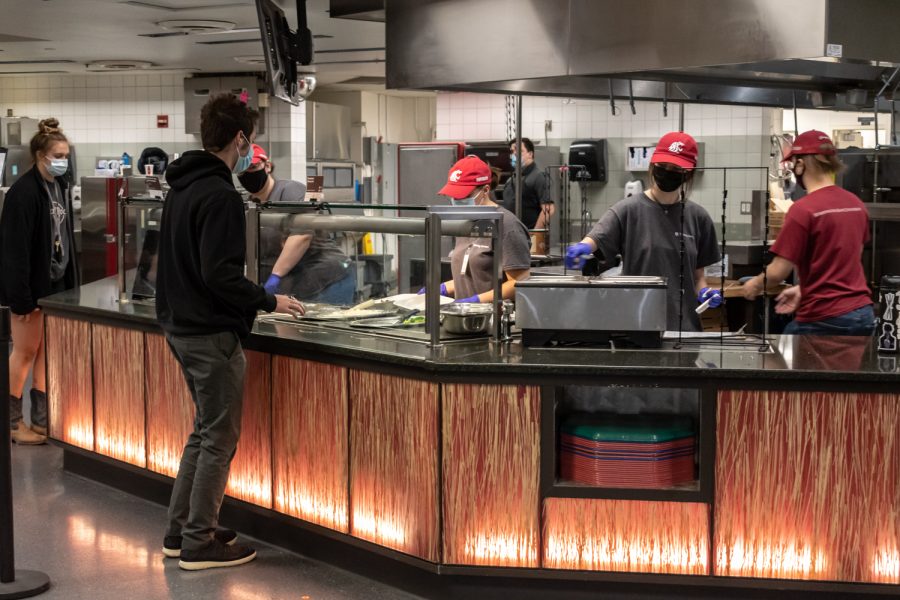Dining Services adapts to supply chain, staffing shortages
Staff wants to make more protein alternatives, gluten-free options available
New grants meant to help fight food insecurity among students, among other issues
November 18, 2021
With students returning to campus this fall, Dining Services has had to adapt to staff and supply chain shortages caused by the pandemic, resulting in changed menus and limited hours.
Southside Market, previously called Flix Café, has a limited menu and hours. When the pandemic hit, Dining Services was unable to use the kitchen because it is very small, Dining Services Director Sarah Larson said. Now, there is a new menu for Southside Market that includes drinks.
At Southside Café, Southside After Hours opened for anyone who is looking for late-night food, Larson said. It is open 8-10 p.m. on Sundays to Thursdays. During these hours, food from the grill, subs, wraps and the salad bar are available.
Supply chain shortages and menus
Before the semester begins, a team of staff creates a four-week cycle menu, said Adam Koerner, culinary operations associate director.
Dining Services has been facing supply chain issues. Menu items such as deli meats are currently limited, Koerner said. This is because most of the school systems are now open, and everyone is currently needing deli meats. Supply chain issues fluctuate, and it is often hard to pinpoint one food item that is part of the shortage.
If Dining Services does not have a specific food that was on the menu, the chefs have to make adjustments to it, Koerner said.
“[The chefs] really have the skill set to take a look at what is available through the supply chain and continue to evolve those menus,” Larson said. “We have a recipe database of over 2,000 to 3,000 items, and so they’re able to respond.”
Staffing
Dining Services is understaffed because few people have submitted applications for full-time positions. However, they have hired a good number of students, Larson said.
This shortage likely has to do with the overall staffing problem going on in the U.S. Applications are still open for Dining Services positions, Larson said.
Trained chefs lead the units at the dining halls, Koerner said. These chefs oversee a staff that includes trained cooks, food service leads, sous chefs and student staff.
All student staff who handle food go through a food handler training program, he said. There is also allergen training. The rest of the training is done in-house by trained culinary staff.
Allergy-friendly foods
Each menu has standards chefs must follow, said Alice Ma, Dining Services registered dietitian. The chefs have creative freedom with the menu, but they need to make sure there are things such as a vegan option, protein options and a healthy option at each dining hall.
Dining Services has protocols in place for those with allergies, Ma said. There is an allergy-friendly area where all the items are made without the top eight most common allergens: peanuts, tree nuts, soy, wheat, eggs, dairy, fish and shellfish.
The natural station is the allergy-friendly station at all three of the dining halls, she said. All food is produced in a separate area, making it safe for those with the top eight most common allergies.
For those who cannot have traditional protein such as chicken or beef, there are protein alternatives. This includes the veggie burger made with black beans and the Beyond Burger at the grill. Tofu is often an option at many of the stations. Carlita’s in the Compton Union Building is using a plant-based barbecue sauce, Ma said.
Portions
When staff are serving food to someone, they use the Sanitas Per Escam (Health Through Food) guidelines for portion sizes, Koerner said. They strive to give each student approximately 4 ounces of protein, 6 ounces of vegetables and somewhere between 4-6 ounces of starches.
Dining Services limits the amount of salt on items. This is because everyone has different opinions on how much salt a specific food item needs, Koerner said. There is salt in the front of the dining halls so people can salt their food to taste.
Cleaning up
After someone finishes eating, they put their dishes at the dishwashing return station, Larson said. There’s a carousel at the station.
Staff sort through the dishes that come from the carousel. The food waste gets composted and recyclables are sorted, Koerner said.
The dishes go into the commercial dishwasher where they are washed, rinsed and sanitized with heat. From there, the dishes air dry and are put back into rotation, he said.
Future changes
As far as improvements, Dining Services is working on making more protein alternatives available, Ma said. Staff would also like to provide more gluten-free options in the bakery line.
For next semester, Dining Services is working on making the menu more seasonally relevant, Larson said.
If anyone is struggling to find food to eat, they can always reach out to Ma. Most dietary restrictions can be accommodated, and Ma said she wants to help students.









